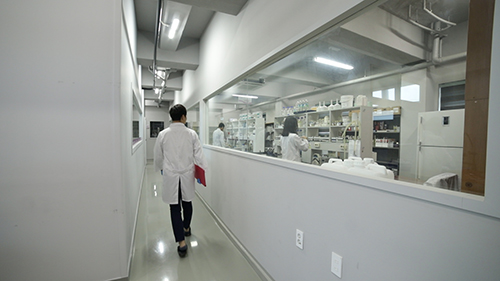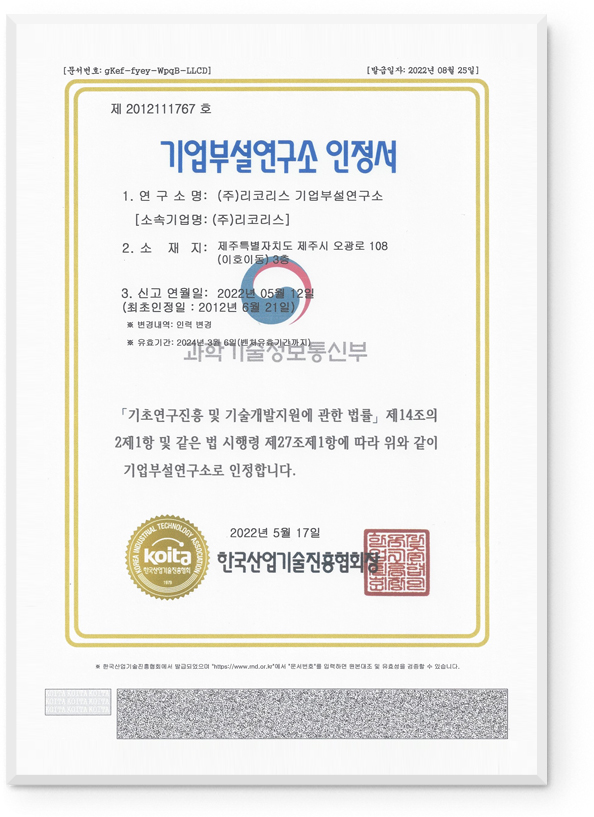리코리스 기업부설연구소
R&D Center
CLASSIFICATION OF AMARYLLIDACEAE
AMARYLLIDACEAE J. St.-Hil.(수선화과)
Herbs, perennial. Roots fibrous. Stems bulbs or rhizomes. Leaves basal, simple, mostly deciduous, alternate, spiral, distichous; sessile or petiolate, sheathing, simple; blade linear, lanceolate, oblong, ovate or orbicular, margins entire.
Inflorescences cymes, umbels, heads or flowers solitary, with or without involucral bracts, spatheaceous; scape solid or hollow.
Flowers regular to irregular, cyclic; perianth parts 6, in 2 whorls, free to joined; stamens (3-)6(-18), free or adnate to perianth tube; ovary inferior, locules 3, placentation axial, ovules 12-50 per locule; style 1; stigmas 1 or 3. Fruit capsules or berries, fleshy or dry, dehiscent or indehiscent.
Seeds few, black, green or red.
Genera ca. 60(6 in Korea), species ca. 800(7 In Korea).
Distribution: Temperate, subtropical, tropical regions.
1. Perianth zygomorphic, pale purple, red, deep yellow, or yellowish white.
2. Leaves appearing in autumn, dark green; perianth red ---------- 1. L. radiata
2. Leaves appearing in early spring, green; perianth yellow, deep yellow, pale purple, or yellowish white.
3. Perianth segments reflexed, undulate at margin ---------- 2. L. chinensis
3. Perianth segments flat, entire at margin.
4. Perianth with red tints.
5. Perianth yellow or yellow with red tints at the margin ---------- 3. L. flavescens
5. Perianth yellowish white, red tints along midrib ---------- 5. L. chejuensis
4. Perianth without tints
6. Perianth ivory white ---------- 4. L. uydoensis
6. Perianth pale purple ---------- 6. L. squamigera
1. Perianth nearly actinomorphic, orange-red. ---------- 7. L. sanguinea
Lycoris Herb., Bot. Mag. 47: 5, sub t. 2113, 1819. 상사화속
Herbs, perennial, bulbiferous. Bulbs tunicate, subglobose to ovoid.
Leaves appearing before or after anthesis, radical, linear or straplike, 2-12, glabrous, entire.
Inflorescences terminal, umbels, 4-10-flowered; involucral bracts 2, linear to lanceolate; scape simple, erect, solid, naked.
Flowers bisexual, nearly actinomorphic or zygomorphic, pedilcellate; perianth funnelform, deeply 6-parted; perianth segments 6,
linear lanceolate to oblanceolate, reflexed at tip or not, sometimes undulate at margin; stamens 6; pistil 1; ovary 3-locular; style
longer than stamens; stigma capitate; ovules about 6 per locule; placentation axile.
Fruit capsules, dehiscent. Seeds globose, black or dark brown.
Chromosome numbers 2n= 12-19, 21-23, 25-28, 32, 33, 43.
Species 20(5 in Korea).
: Temperate woodlands. open grassy areas in E Asia.
1. Perianth zygomorphic, pale purple, red, deep yellow, or yellowish white.
2. Leaves appearing in autumn, dark green; perianth red ---------- 1. L. radiata
2. Leaves appearing in early spring, green; perianth yellow, deep yellow, pale purple, or yellowish white.
3. Perianth segments reflexed, undulate at margin ---------- 2. L. chinensis
3. Perianth segments flat, entire at margin.
4. Perianth with red tints.
5. Perianth yellow or yellow with red tints at the margin ---------- 3. L. flavescens
5. Perianth yellowish white, red tints along midrib ---------- 5. L. chejuensis
4. Perianth without tints
6. Perianth ivory white ---------- 4. L. uydoensis
6. Perianth pale purple ---------- 6. L. squamigera
1. Perianth nearly actinomorphic, orange-red. ---------- 7. L. sanguinea
1. Lycoris radiata (L'Hér.) Herb., Bot. Mag. 47: 5, 1819.
Basionym: Amaryllis radiata L'Hér., Sert. Angl. 3: pl. 15, 1792.
Korean name: Seok-san(석산)
Flowering early Sep.
Distribution: Asia.
Korea: All provinces. Open mountain slopes and lowlands.
2. Lycoris chinensis Traub, Pl. Life 14:44, 1958.
Var. sinuolata K. Tae & S. Ko, Korean J. Pl. Taxon. 23: 234, 1993.
Korean name: Jin-no-rang-sang-sa-hwa(진노랑상사화)
Flowering late Jul to early Aug.
Distribution: Restricted to Korea.
Korea: JB, JN. Open mountain slopes. Endemic.
3. Lycoris flavescens M. Kim & S. Lee, Korean J. Pl. Taxon. 34: 13, 2004.
Korean name: Bulk-no-rang-sang-sa-hwa(붉노랑상사화)
Flowering Aug.
Distribution: Korea.
Flowering late Aug to early Sep.
Distribution: Korea.
Korea: JB, JN, GG(Ganghwa-do). Endemic.
4. Lycoris uydoensis M. Kim, Korean J. Pl. Taxon. 34: 14, 2004.
Korean name: Uy-do-sang-sa-hwa(위도상사화)
Korea: JB(Uy-do). Endemic.
5. Lycoris chejuensis K. Tae & S. Ko, Korean J. Pl. Taxon. 23: 234, 1993.
Korean name : Je-ju-sang-sa-hwa(제주상사화)
Flowering Aug.
Distribution : Restricted to Korea.
Korea: JJ. Endemic.
This species is characterized by its yellowish white perianth segments tinged red along midrib.
Individuals in the sun have more red than those in the shade.
Flowering late Jul to Aug.
Distribution: E Asia.
6. Lycoris squamigera Maxim., Bot. Jahrb. Syst. 6: 79, 1855.
Korean name : Sang-sa-hwa(상사화)
Korea: All provinces. Cultivated.
7. Lycoris sanguinea Maxim., Bot. Jahrb. Syst. 6: 80, 1885.
Var. koreana (Nakai) Koyama, Baileya 7: 6, 1959.
Basionym: Lycoris koreana Nakai, Bot. Mag.(Tokyo) 44: 516, 1930.
Korean name : Baek-yang-kkot(백양꽃)
Flowering late Aug to early Sep.
Distribution: Japan, Korea.
Korea: JB, JN, GN. Open mountain slopes.


특허출원 및 등록
-
1. 장딸기 열매 추출물 및 마유를 함유하는 피부 보호용 화장료 조성물
Cosmetic composition comprising the fruit extract of Rubus hirsutus Thunb.
Patent Date & Number: Oct. 9, 2012. 10-1191140
and horse fat for skin care. -
2. 저온처리공정을 이용한 말태반 추출물의 제조방법,
이로부터 제조된 말태반추출물 및 이를 함유하는 식품 조성물Process for preparing horse placental extract by low temperature treatment,
Patent Date & Number: Jan. 24, 2011. 10-1011772
horse placental prepared therefrom and food composition having the same. -
3. 말태반 추출물을 함유하는 주름개선 화장료 조성물
Cosmetic composition having anti-wrinkle effect containing the horse placental extract.
Patent Date & Number: Oct.6, 2010. 10-0987302 -
4. 엘라직산을 유효성분으로 포함하는 피부 미백활성을 갖는 장딸기의 열매추출물
Fruit extract of Rubus hirsutus Thunb. having skin whitening activity containing ellagic acid.
Patent Date & Number: Dec. 28, 2009. 10-0935329 -
5. 엘라직산을 유효성분으로 포함하는 피부 미백활성을 갖는 재배딸기류의 잎 추출물
Leaf extract of Fragaria ananassa Duchesne Complex having skin whitening activity containing ellagic acid.
Patent Date & Number:June 23, 2009. 10-0905388 -
6. 고순도의 4-엔-부틸레조시놀 결정을 제조하는 방법
Method of fabricating 4-n-butylresorcinol crystalline of high purity.
Patent Date & Number: Apr. 22, 2009.10-0895586 -
7. 동백나무 열매 추출물을 함유하는 숙취해소용 조성물
An alcohol detoxification composition comprising fruit extract of Camellia japonica.
Patent Date & Number: Mar. 27, 2012.10-0030907 -
8. 마유 및 동백나무 열매 추출물의 혼합물을 함유하는 주름 개선 또는 피부재생 촉진용 조성물
Composition comprising horse fat and fruit extract of Camellia japonica for improving wrinkle or promoting skin-regeneration.
Patent Date & Number: Jan. 6, 2014. 10-1350222 -
9. 동백나무 열매 추출물을 함유하는 항산화 또는 미백용 조성물
A composition comprising fruit extract of Camellia japonica having antioxidant and whitening effect
Patent Date & Number:JUN. 10, 2014. 10-0031838 -
10. “Lycoris" 중국상표등록 제 12592450 호

논문발표
-
2010
Lysimachia quelpaertensis (Primulaceae), a new species from Jeju Island, South Korea. Korean J.
Pl. Taxon. 40(2): 108-112. -
2009
Taxonomic reexamination based on morphological characters of the Rubus hongnoensis Nakai.
Korean J. Plant Res. 22(5): 473-476. -
2009
Establishment of high frequency plant regeneration system from leaf explants of Pinellia koreana via
bulblets formation. Kor. J. Plant Biotechnology. 36(2): 193-196. -
2008
Relationship of Lycoris (Amaryllidaceae) based on RAPD Makers. Korean J. Pl. Taxon. 38(1): 17-29.
-
2008
Genetic variation and relationships of Pericaria thunbergii (Sieb.&Zucc.) H.
Gross ex Nakai (Polygonaceae) by the RAPD analysis. Kor. J. Plant Res. 21(1): 66-72. -
2007
Plant regeneration from leaf and root cultures of Lycoris chejuensis via bulblet formation. Kor.
J. Plant Biotechnology. 34(3): 223-227. -
2007
RAPD anlyses on the regional population of two species of Saururaceae in Korea. Kor.
J. Plant Res. 20(4): 272-280. -
2007
A taxonomic study of Lysimachia sect. Spicatae (Primulaceae) based on morphological characters.
Kor. J. Pl. Tax. 37(1): 61-78. -
2006
Arisaema thunbergii subsp. geomundoense S.C.Ko (Araceae), a new subspecies from Korea. Kor.
J. Pl. Tax. 36(3): 209-216. -
2006
Unrecorded species in Korea: Monochasma sheareri (S. Moore) Maxim. ex Franch. et Sav.
(Scrophulariaceae). J. Plant Biology. 49(4): 336-338. -
2005
Genetic variation and phylogenetic relationships of tribe Forsythieae (Oleaceae) based on RAPD
analysis. Korean J. Plant Res. 18(2): 135-144. -
2005
Analysis of phylogenetic relationship among Korean Pinellia Tenore (Araceae) using RAPD markers,
Korean J. Pl. Tax. 35(3): 161-174. -
2005
Pinellia koreana (Araceae), A new species from Korea. Novon. 15(3): 484-487.
-
2005
A systematic study of Abeliophyllum distichum (Oleaceae) based on cytological characters.
Korean J. Pl. Taxon. 35(2): 143-151. -
2005
Characteristics of flowering habit, pollination patterns and seed setting of Hosta plantaginea Aschers.
Korean J. Plant Res. 18(2): 309-314. -
2005
Somatic embryogenesis and plant regeneration in leaf and petiole explant culture and cell suspension
cultures of Pinellia tripartita. Plant Cell, Tissue and Organ Culture 80 : 267-270.







